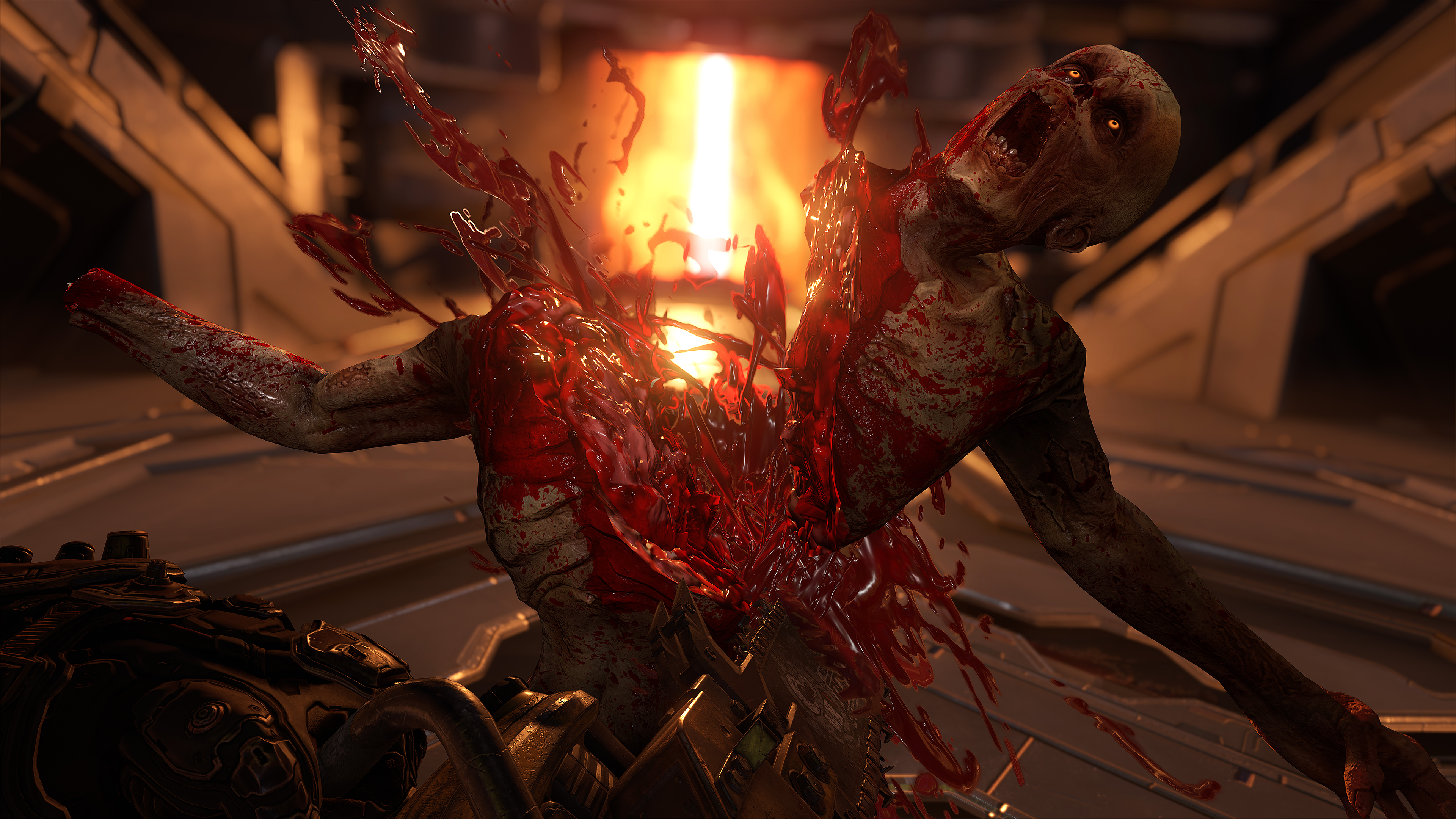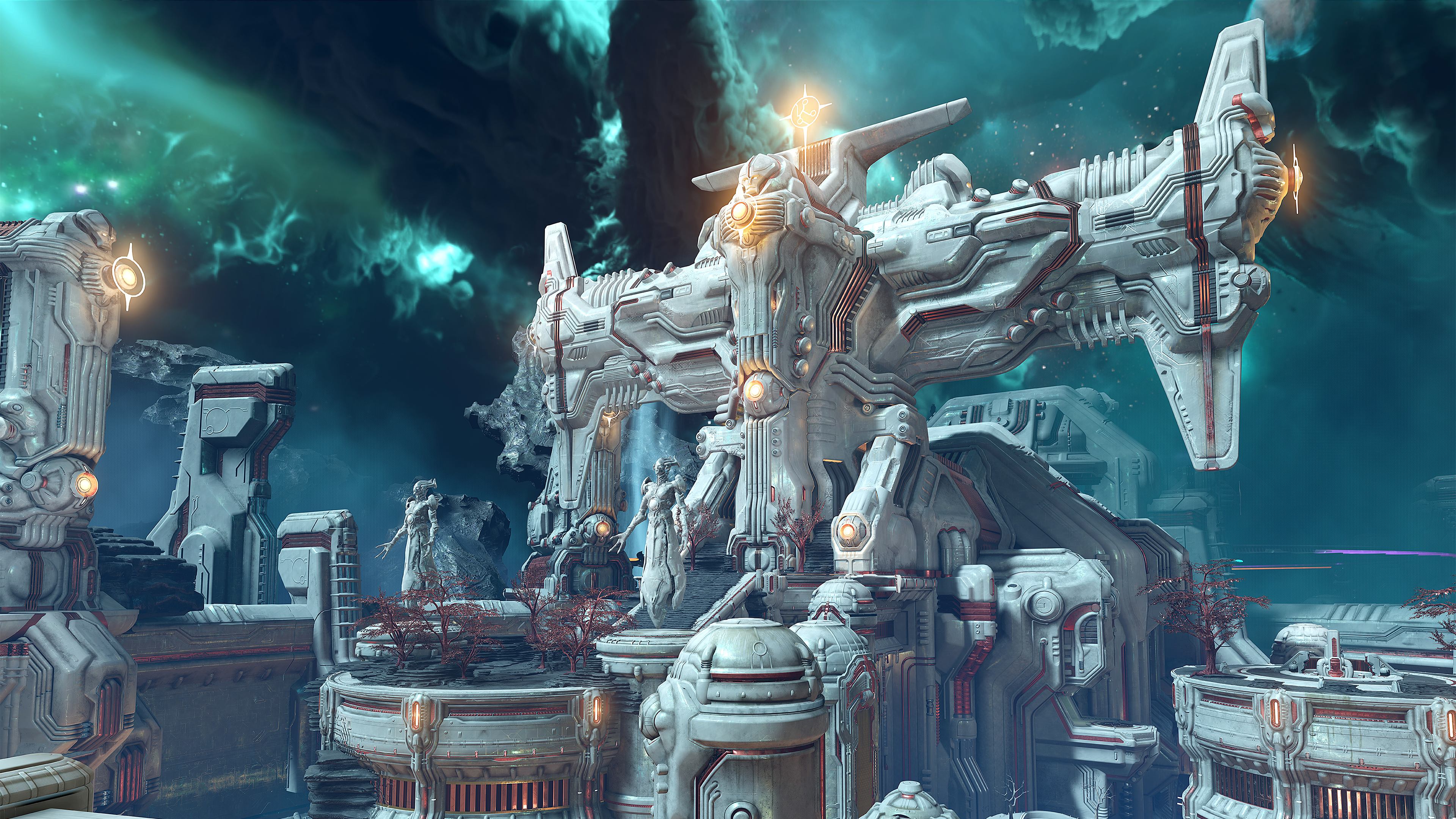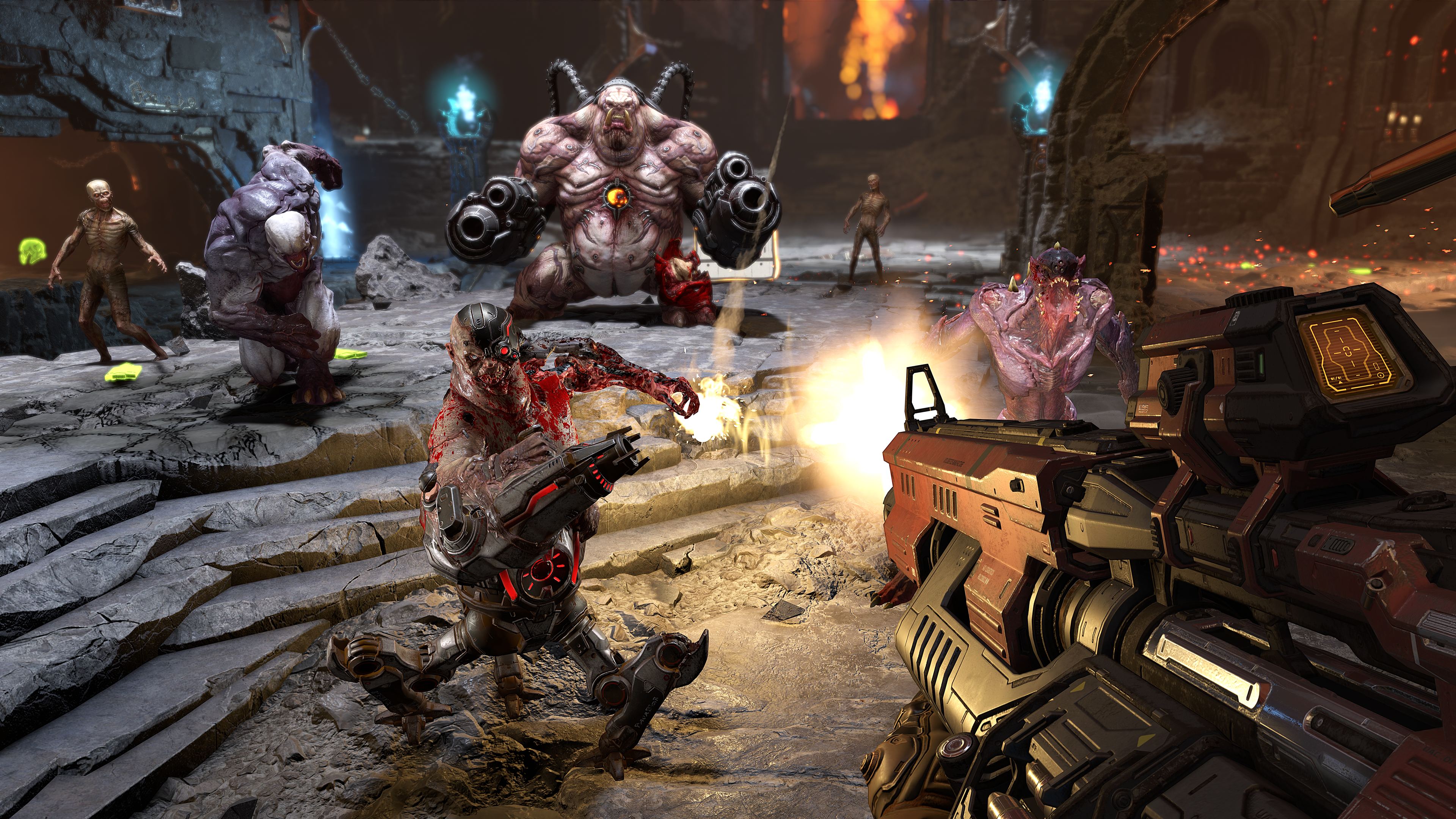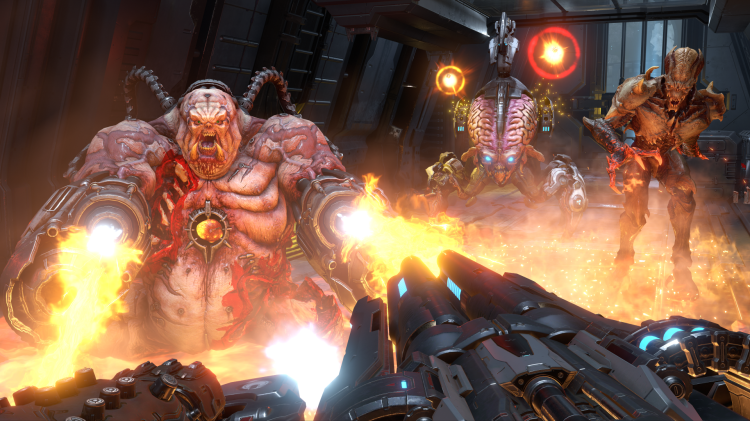Doom Eternal is one of the more exciting sequels in delevopment. The Doom reboot of 2016 shocked a lot of people, including me, with its quality. Doom seemed like old news. Now it’s maybe the best single-player first-person shooter series out there.
Eternal is coming out for PlayStation 4, Xbox One, Switch, Stadia, and PC. Executive producer Marty Stratton and creative director Hugo Martin are looking to top what they did with the last Doom. This means finding ways to improve the experience, which can be difficult when your last game had so much praise.
We talked with Stratton and Martin about the lessons learned from Doom’s 2016 reboot and how Eternal can benefit from them. We also learn more about how Doom Eternal is running on Stadia, Google’s upcoming game-streaming service.
GamesBeat: How did it feel to see the positive reception to the last Doom?
Hugo Martin: It was amazing. We loved it. It was such a journey for our team over the course of the few years we were building it. When we went into launching it, I think there was kind of–some level of skepticism as to whether or not it would be good, whether or not our team could deliver. We had a ton of confidence. We felt really good about what we’d made. When we put it out there and really started to hear people talk about–not just saying it’s good, because we know it’s good, but when you hear people talking about the intricate things that you spend a lot of time obsessing about and it means something to them, I think that’s probably the most rewarding thing. That was the most rewarding thing for me.
GamesBeat: How quickly after that shipped did you start working on Eternal?
Martin: Pretty much immediately. We did a number of things for DLC for Doom 2016. We did some multiplayer DLC. We’ve had teams working on bouncing through different projects. We had a group working on the Doom VR project. But preproduction started right after 2016. Certainly we were well into early production in 2017.
GamesBeat: What does the “Eternal” in Doom Eternal mean?
Marty Stratton: That your fight is Eternal. It’s the eternal struggle between good and evil. It’s meant to symbolize that there’s always going to be demons and there’s always going to be a Slayer.

Above: Chainsaws are always effective against demons.
GamesBeat: Traversal has gotten an update with this game. You can now wall climb. Why did you add this?
Martin: We needed to make the areas of the levels outside of the arenas better, pretty much. We had hallways to arenas and the arenas were really good, but we wanted to make sure — we call those spaces incidental combat spaces. Basically, non-arena combat spaces. We wanted to make every inch of the level enjoyable. Not just the big fights. We gave the player a small but effective set of abilities that we expand throughout the game to allow them to basically — allow us to create an engaging experience for the player. Give you something to solve. Traversal and environmental puzzles to solve, places to get into, things to figure out. It allows us to engage the player in a lot of different ways.
Stratton: We’ve also said that the Slayer goes places that normal men cannot. That’s how he gets places, how he does things. From a design perspective, as that was solved — it’s pretty heroic to double jump, to basically jump off of an asteroid hurtling through space, double dash, and then cling to the side of it and climb up it. Those things fit from a gameplay perspective, but also tonally, with what we tried to do with the Slayer.
Martin: And that’s only one version of it. If you play other levels, they don’t play anything like that. The theme of this level is more about the double jumps and going through space. Other levels capitalize on other abilities that you haven’t seen yet. It’s really varied throughout the game.
GamesBeat: Was it difficult to decide what needed to change from the last game and what needed to stay the same?
Stratton: The consumer is never really wrong, to be honest with you. They’re pretty vocal. If you pay attention to the response and you look at your game honestly, draw your own conclusions and listen to what the fans are saying and what the critics are saying, I think it was pretty easy to figure out where there was room for improvement.
GamesBeat: What is one of the big areas where you’re using player feedback?
Stratton: The game was repetitive. That we ran out of tricks in the fourth quarter. We have more AI now to account for that. The game is going to be engaging from beginning to end. You won’t feel like, well, they’ve run out of stuff to give us, and now it’s going to be more of the same. We love every moment of the game. I think some of the final levels of Doom 2016 are the most satisfying.
Martin: Yeah, really. It’s a shame people don’t finish it. But that’s always the case with games.
Stratton: We think that we’ve got more stuff to give you as you go through the game this time around.
GamesBeat: The new Doom franchise feels so different from modern shooters. What do you look to for inspiration?
Martin: I don’t know. We pull inspiration from everywhere. Even movies, books, comics, games, Just looking at games as an experience. What makes a compelling experience? I think if you try to follow what other people are doing too much, you’ll fall into — you’ll be following trends a lot. It’s gotta be good for Doom. That’s really always our focus. What’s good for Doom?

Above: Doom isn’t all red. Behold, blue!
GamesBeat: What aesthetically sets Doom Eternal apart from its predecessor?
Stratton: I would say — so much — there are areas where I would say we’ve pushed, pushed hard. The Slayer, his attitude, the tone of how he does things, that’s just, I would say, pushed even further. But then when you look at what the team has done with the universe, building the universe, and the variation — Hugo talks about the variation in the gameplay, but the variation in the worlds — when you look at 2016 it was pretty much either Mars or Hell. This is just so varied. You’re going from Mars to Hell to Phobos to Sentinel World to Earth to places that you never even imagined in a Doom game before. I think that’s one of those things that — I’m super excited for players to start to go through it and think, my God, I can’t believe I’m playing a Doom game.
GamesBeat: How is this playable on Stadia? Is it the same game?
Stratton: More or less. It won’t be any slower. I was just playing it the other day. It’s pretty awesome. I’m a big believer in streaming. We’re obviously working with Google on that stuff. We were part of their press conference. Sometimes it feels like magic. We have this exact demo up and running on Stadia. It’s fantastic, it really is.
GamesBeat: It doesn’t need a lot of custom work to do Stadia? Do you essentially build for the PC and then that works for Stadia?
Stratton: More or less. We’re particularly well-positioned for it because our game is built on Vulkan and Stadia is built on Vulkan. Those two things really make it fairly straightforward. I say that not having been the one who does the work. But that’s why Google wanted to partner with us early on with Doom 2016 and why we have Doom Eternal in such a good place on it. But yeah, it’s effectively a high-end PC in the cloud. For the most part, it plays like that. You have it going through the video encoder and then you’re playing it in your browser.
GamesBeat: Is it good that it’s single-player? Will that make it easier to do?
Stratton: The expectation is that any type of multiplayer experience is also really good. The interesting thing is that — I’m trying not to go too much into the Stadia stuff. But when you think about it, you’re not — because the computer you’re playing on is in the cloud, you’re not having to worry about the network connection as well. The only data being transferred is your input and the video coming in. Even if you’re online. The online connection between multiple computers is between the computer in the cloud and another computer, if it’s another Stadia computer, in the cloud. A lot of times those two computers can communicate much faster than two Xboxes, because they may even be in the same cluster. The networking connection, the lag between the two Stadia computers, is super minimal. All you’re still worrying about is your video speed and your input speed, which stays consistent whether you’re playing campaign or multiplayer. That’s one of the exciting things about it. You can have some pretty great online experiences that are no different than campaign.

Above: That’s a lot of stuff to shoot.
GamesBeat: With Doom 2016 you had a lot to prove, notably that Doom was still a viable franchise. What do you think you have to prove with Doom Eternal?
Martin: That we can do better. We have to do better. If you just meet people’s expectations, you’ll fall below them. I think you have to surpass their expectations to truly meet their expectations. Everything going into this game — people can feel that it could be special. It’s like hearing about a movie that’s being announced, and you think, oh man, this could be really good. And like with Endgame, if you don’t show up and watch Avengers Endgame and it isn’t really good, you’re going to be disappointed. I think that — this has to be — we’re motivated and focused on delivering….
Stratton: Something special.
Martin: Something really special.
GamesBeat: Otherwise it’s like Game of Thrones.
Martin: It’s true, though. Game of Thrones might be really good, but if it’s not fucking awesome, people go nuts.
Stratton: And you’re only as good as your last thing. For us, that’s a huge motivation. We have way more we want to do. We just want to keep surprising people.

